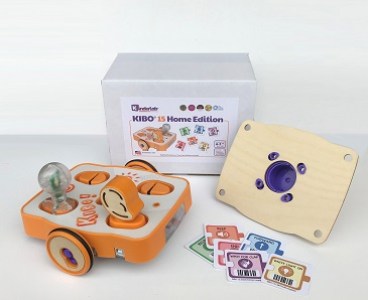See full article at its source: https://www.smartbrief.com/original/2021/12/integrating-culture-and-history-robots

“My school, the New England Jewish Academy,
is a dual-curriculum school. I teach general studies to students in 1st
and 2nd grade for half of the school day, and my students spend the
other half of their days with a Hebrew teacher and a Judaics teacher.
That means I get about half the time to teach the same content that
teachers who work with students all day get.
One of the ways I make the most of my instructional time is by
integrating different content areas into the same lessons, sometimes in
surprising ways. This year, for example, I have been working with my
students’ Judaics teacher, Shifra Silver, to combine STEM learning with
lessons about Jewish holidays.
A robot ritual
This year our principal, Rabbi Zev Silver, introduced me to a
screen-free educational robot called KIBO. As we looked through
resources and lessons for using it, we came across the Limudei Code-Esh (LCE) project from a partnership with Tufts University and the David Lear Sulman Fund.
LCE is a STEAM program that integrates coding and computational
thinking through six Jewish holidays: Sukkot, Chanukkah, Tu B’shevat,
Purim, Pesach, and Yom Ha’atzmaut. It was created as a collaboration
between Tufts Professor Marina Bers, the co-creator of KIBO, and Jewish
educators from orthodox, conservative, and reform day schools and
supplemental schools,
We began with the unit for Sukkot,
which includes a ritual where participants gather a palm frond, a
myrtle leaf, and a willow branch. They bind them together to form a
bundle called a lulav, and then shake them together with a citron in
each of the cardinal directions, as well as up toward the sky and down
toward the ground, all the while walking around a table reciting a
prayer. The ritual is a reminder of the time that the Jewish people
spent wandering in the desert, and a celebration of how they found what
they needed to survive and thanked God for it.
Since we were more interested in ensuring the students understood the
ritual than gathering materials, my students’ Judaics teacher Shifra
Silver put together lulavs for the students with green toothpicks,
little frilly pieces that looked a bit like leaves, and yellow push pins
for the citron that would hold the whole thing together. We started by
having students program their robots to perform the shaking part of the
ritual, but expanded the focus on having them teach their robots to
“walk” around a small table called a bimah that we set up on the floor.
We provided craft materials to the students, as well as art platforms for them to attach to the KIBO kit to carry the lulav on..
…Helen Schwartz teaches 1st and 2nd grade at the New England Jewish Academy, where she recently used KIBO to help her students celebrate Hannukah. She can be reached at hschwartz@neja.org.”